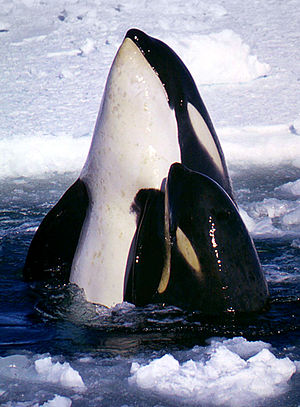Orca (Orcinus orca)
The killer whale (Orcinus orca), also known as orca, is the largest member of the dolphin family and the top predator in the ocean. They are found in all oceans, from the polar regions to the tropics, and have a varied diet and culture depending on their population and ecotype. Some populations of killer whales are endangered or depleted due to human activities, such as hunting, overfishing, pollution, and noise disturbance.

Description
Orcas are mostly black on top with white undersides and white patches near the eyes. They also have a gray or white saddle patch behind the dorsal fin. These markings vary widely between individuals and populations. Adult males develop disproportionately larger pectoral flippers, dorsal fins, tail flukes, and girths than females.
Types
Orcas have a cosmopolitan distribution and several distinct populations or types have been documented or suggested[1]. Three to five types of orcas may be distinct enough to be considered different races, subspecies, or possibly even species[1]. The IUCN reported in 2008, "The taxonomy of this genus is clearly in need of review, and it is likely that O. orca will be split into a number of different species or at least subspecies over the next few years."[1].
In the eastern North Pacific Ocean, there are three distinct types of orcas recognized—transient, resident, and offshore.[2] Residents live close to shore in large pods of about 10 to 20 individuals and feed primarily on fish.
Offshore orcas are similar to residents but are distinguished by their smaller overall size and rounded, nicked fins.[2]
Behaviour
Killer whales are highly social, and most live in social groups called pods (groups of maternally related individuals seen together more than half the time) where they hunt together and share responsibility for raising young and taking care of the sick or injured.[3] Individual whales tend to stay in their natal pods. Pods typically consist of a few to 20 or more animals, and larger groups sometimes form for temporary social interactions, mating, or seasonal concentrations of prey.
Killer whales rely on underwater sound to feed, communicate, and navigate. Pod members communicate with each other through clicks, whistles, and pulsed calls. Each pod in the eastern North Pacific possesses a unique set of calls that are learned and culturally transmitted among individuals. These calls maintain group cohesion and serve as family badges.
Communication
Orcas communicate through pulsed calls and whistles, which form a unique dialect for a family. They express their identity through their cultural habits, and their prey choices are central to this, and so it shapes their language. Orca language is learned and inherited, and just like human babies, orcas can hear their mother in the womb, and so they’re learning their family’s language before they’re born[4].
The Southern Resident killer whales’ language is so sophisticated that it contains three distinct dialects, one for each of the pods—J, K, and L—with vocalizations that are unique to each pod. However, some calls are common across all three pods, facilitating communication across the community, which allows them to socialize, bond, and mate with other pod members[4].
Diet
Orcas have a diverse diet, although individual populations often specialise in particular types of prey. Some feed exclusively on fish, while others hunt marine mammals such as seals and other species of dolphin[5]. Their diet consists of chinook and coho salmon, herring, halibut, rockfish, and mackerel[6].
Killer whale pods have eating habits comparable to the individual food cultures of different countries. Variation in diets across pods is very common, even when they live in the same habitat, as each pod learns a different set of hunting behaviors that dictate what prey they catch and eat[7].
Hunting
Orcas are precise and efficient hunters that use different strategies depending on their prey and region[8]. They feed on over 140 species, including great white sharks, which they rip open for their livers and hearts¹. They can flip the sharks over to induce a state of paralysis and make them easy to eat[8]. They can also come ashore to hunt seals and sea lion pups, hiding their dorsal fins and beaching themselves[8].
Some Antarctic orcas use the cunning tactic of regularly hunting in packs and making waves to wash seals off floating ice⁶. These hunting techniques are almost ritualistic and are passed down from generation to generation.
Captivity
Orcas have been captured from the wild for display in captive facilities since the 1960's.[9] The first orca to be captured in 1961 was found off the coast of California and given the name Wanda.[9] Many orcas are held in captivity for breeding or performance purposes[10]. They soon became popular attractions at public aquariums and aquatic theme parks due to their intelligence, trainability, striking appearance, playfulness, and sheer size[10].
The practice of keeping orcas in captivity is harmful to the animals due to the separation from their familial pod during capture, and their living conditions and health in captivity.[10]
Taxonomy
Familia: Delphinidae
Genus: Orcinus
Species: O. orca
See also
External links
- Orca's Extraordinary Hunting Technique BBC Earth - YouTube
References
- ↑ 1.0 1.1 1.2 Orca types and populations Wikipedia
- ↑ 2.0 2.1 Meet the different types of orcas Whale & Dolphin Conservation USA.
- ↑ Orcas are social mammals MedCrave online
- ↑ 4.0 4.1 How do orcas communicate Wild Orca
- ↑ Orca diets provide insight into climate change impacts on Arctic food
- ↑ What do killer whales eat? Natural History Museum
- ↑ What Do Killer Whales Eat? Discover the Orca Diet Wildlife Trip
- ↑ 8.0 8.1 8.2 Three Amazing Orca Hunting Strategies We Are Sonar
- ↑ 9.0 9.1 Orca Captivity Orca Aware
- ↑ 10.0 10.1 10.2 Fate of orcas in captivity Whale and Dolphin Conservation.